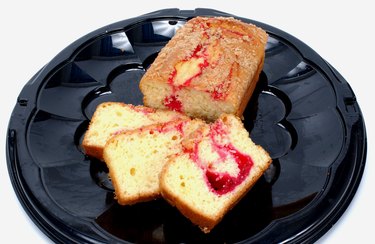
Sometimes it's possible to have the best of both worlds. Bakers generally sort cakes into two types: those whose loft and texture come from fat; and those whose loft and texture come from eggs. Two classic cakes, sponge and genoise, rely on eggs for their height and lightness. How ingredients are chosen and combined illustrate how even simple baking formulas can be modified to produce markedly different results.
American Sponge
Video of the Day
Both classic American sponge cake and European butter-sponge cake contain eggs, sugar and flour. For sponge cake, eggs are separated and the yolks are beaten with sugar. Once you have gently folded the sifted flour into the yolks, you can fold stiffly beaten egg whites into the mixture. Contact with liquid activates a small portion of the gluten in the flour, making the mixture more able to retain air bubbles. A sponge cake is ideally moist and light at the same time.
Video of the Day
Genoise
Similar ingredients to a sponge cake, with one major addition, are assembled differently to create a classic genoise, or European-style butter-sponge. Both the assembly method and the addition of butter stem from differences between European and American flours, notes pastry chef Jenni Field on her website, PastryChefOnline.com. Because European flours are lower in protein, or gluten, than U.S. ones, flour contributes less to the structure of the cake. Beating whole eggs for a prolonged period over heat with sugar begins a coagulation that keeps air bubbles trapped for rising. Butter is added to increase moisture and tenderness. Despite the butter, genoise tends to be drier and chewier than American sponge.
Beating American Sponge Batter
The key to a good sponge cake lies in beating egg yolks thoroughly with sugar. After at least three minutes, the mixture should be light lemon-yellow and thick. Poured slowly from a spoon, it will fall like a ribbon. This mixture is now full of tiny air bubbles. Beating egg whites is your second step. Vigorous beating incorporates air into egg whites. After two minutes, stop beating and lift the beaters. When peaks stand without softening, the egg whites are full of air.
Folding an American Sponge Batter
Use a gentle, scooping stirring motion, commonly called folding, to combine ribbony egg yolks and flour, then add egg whites. Fold only till you see faint streaks of flour and small lumps of egg white. You have now incorporated and retained as much air as possible into your batter.
Beating a Genoise Batter
A genoise relies on beaten whole eggs for its loft. According to "Cake Bible" author Rose Levy Beranbaum, the key to successful beating of whole eggs is time. Recipes advise beating eggs with sugar up to five minutes over hot water, which brings the egg mixture to a temperature of between 110 and 120 degrees Fahrenheit. While the mixture may look thick and air-filled after less beating, continuing for the full time ensures the egg-sugar matrix has begun its necessary coagulation.
Folding a Genoise Batter
Add flour in several small batches and lightly incorporate it with folding strokes. Then add the melted butter. Room-temperature and clarified, with milk solids strained out, butter can be quickly folded in with a few gentle strokes. As with an American sponge batter, your goal is to retain the air bubbles formed by beating.
Baking and Finishing
Despite their differences, both cakes benefit from being baked in ungreased pans, so batter can adhere to the pan walls, and from being cooled with pans inverted. Steam from cooking reabsorbs into the cake, adding moisture, and making it easier to remove it from the pan. A cooled American sponge cake can be glazed, frosted or served plain. Flavoring is often added to a genoise after it has cooled, in the form of liqueur- or fruit-flavored syrup. Top either cake with fresh fruit and whipped cream for a light-textured pretty and festive treat.
- Joy of Baking: Foam Cakes
- Baking 911: Genoises
- Real Baking with Rose: Fear of Genoise
- PastryChefOnline.com: Basic Lemon Sponge Cake: The Egg Foam Method--That's a Whole Different Cake
- Southern Utah University: Cakes
- Baking 911: Sponge Cakes
- Baking 9ll: Eggs - Beating Techniques for Egg Whites
- Epicurious: Cakes: Recipes and Tips: Types of Cakes